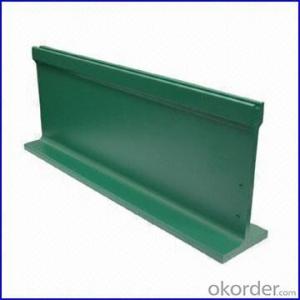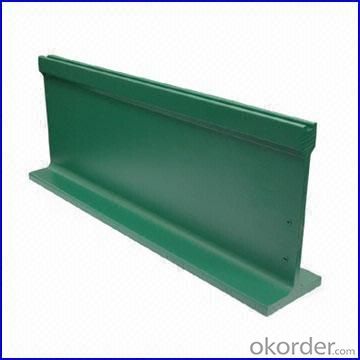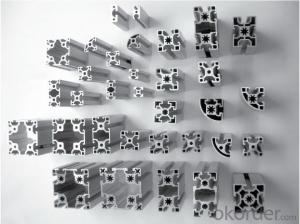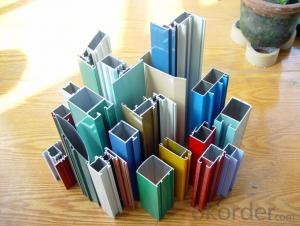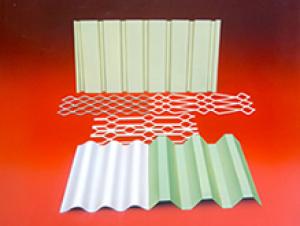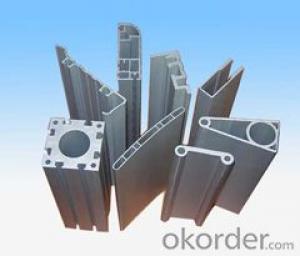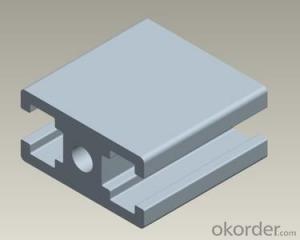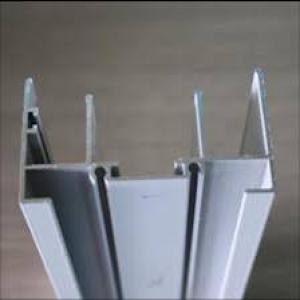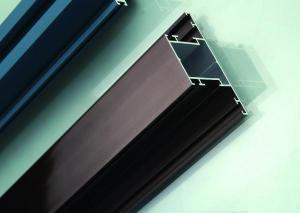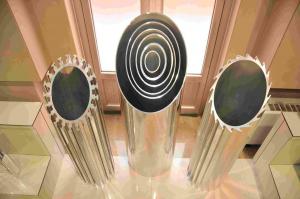Round Aluminum Extrusion Profiles for Decoration
- Loading Port:
- China Main Port
- Payment Terms:
- TT OR LC
- Min Order Qty:
- -
- Supply Capability:
- -
OKorder Service Pledge
OKorder Financial Service
You Might Also Like
Aluminium is a relatively soft, durable, lightweight, ductileand malleablemetalwith appearance ranging from silvery to dull gray, depending on the surfaceroughness. It is nonmagnetic and does not easily ignite. A fresh film ofaluminium serves as a good reflector (approximately 92%) of visible lightand an excellent reflector (as much as 98%) of medium and far infraredradiation. The yield strength of pure aluminium is 7–11 MPa,while aluminium alloys have yield strengths ranging from200 MPa to 600 MPa. Aluminium has about one-third the densityand stiffness of steel. It is easily machined,cast, drawn and extruded.
Features:
Material | Alloy 6063,6061,6005or according to customer’s choice |
Temper | T3, T4, T5, T6 |
Surface | Anodize, electrophoresis, powder coating, PVDF coating, wood grain painting, matted, etc. |
Length | Coating 6.5 meters, Anodizing 6.5 meters, Mill finish 5 meters |
Application | Industrial, electrical equipment(TV set, air conditioner, refrigerator, computer), decoration,construction, transportation |
Custom Made | We can package following with customer's request. |
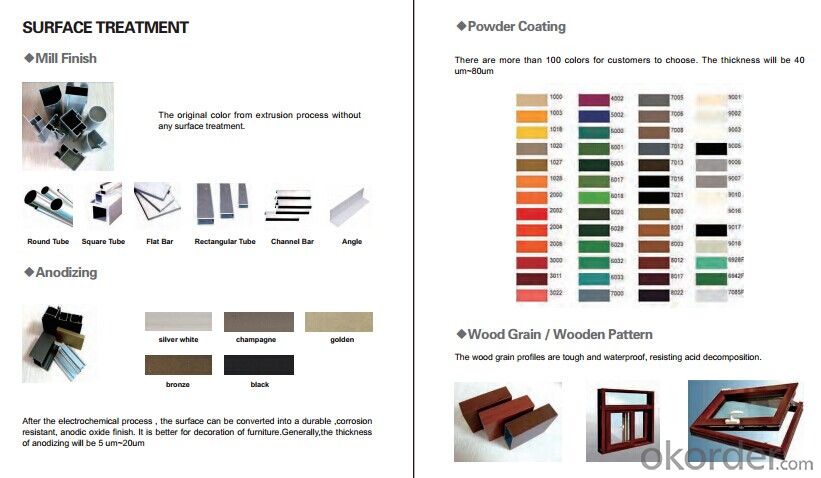
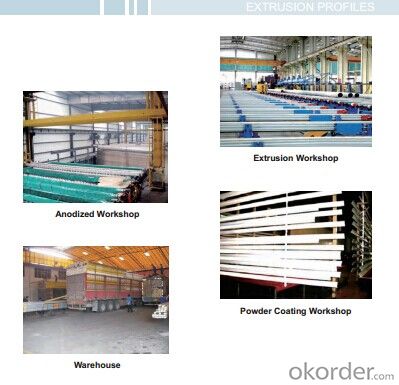

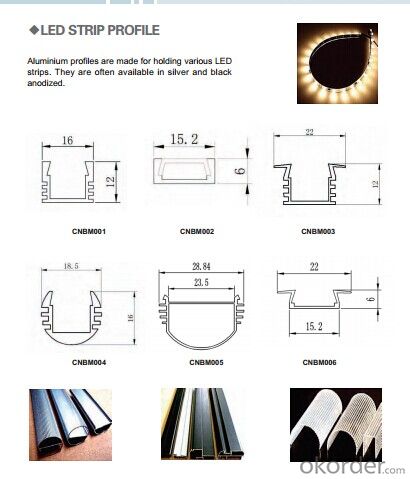
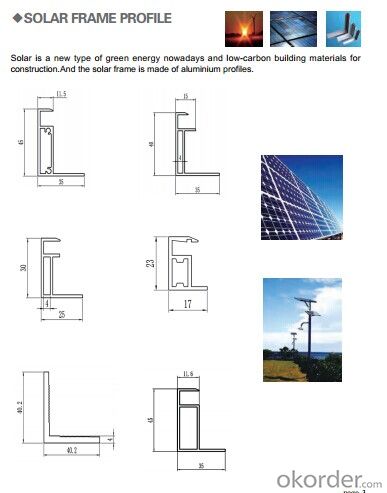

- Q: This question asks for various methods of producing aluminum profiles in a manner that is both efficient and cost-effective.
- <p>Efficient and cost-effective manufacturing of aluminum profiles can be achieved through several methods: 1) Using advanced extrusion technology, which is the primary method for shaping aluminum profiles, allows for high production rates and consistent quality. 2) Implementing automation in the production process to reduce labor costs and increase output. 3) Employing recycling techniques to use scrap aluminum, which lowers material costs and is environmentally friendly. 4) Optimizing the design of profiles to reduce material usage without compromising strength. 5) Utilizing energy-efficient equipment and processes to minimize energy consumption. 6) Regular maintenance and upgrading of machinery to ensure operational efficiency and reduce downtime. 7) Implementing just-in-time inventory management to minimize storage costs and reduce waste. 8) Continuous improvement through research and development to find new, more efficient methods of production.</p>
- Q: It is now the most urban rail trains, as well as the manufacturing methods and processes of large parts profiles used in the manufacture of CRH3 type emus.
- According to the technical requirements of the components, the process is as follows: aluminum ingot - Dissolution alloy ratio - into rod material - extrusion forming - aging - surface treatment - cut by component size - finished product!
- Q: This question asks for a list of various types of coatings applied to aluminum profiles to prevent corrosion.
- <p>Aluminum profiles are protected from corrosion through several types of coatings. These include: Anodizing, which forms a protective oxide layer; Powder Coating, a durable and weather-resistant finish; Electrophoretic Deposition (E-coat), offering a smooth, corrosion-resistant surface; Fluoropolymer coatings, known for their exceptional chemical resistance and UV stability; and Thermal Spray Coatings, which provide a hard, wear-resistant surface. Each method serves to enhance the aluminum's resistance to environmental factors and extend its lifespan.</p>
- Q: Are aluminum profiles suitable for roofing systems that need to withstand strong wind loads?
- <p>Yes, aluminum profiles can be used for roofing systems that require high levels of wind load resistance. Aluminum is a lightweight yet strong material with excellent resistance to corrosion and weathering. It can be engineered into profiles that provide the necessary structural integrity to withstand high wind loads. The flexibility of aluminum allows for the creation of various shapes and designs that can be tailored to meet specific wind resistance requirements. Additionally, aluminum's durability and low maintenance make it a popular choice for roofing systems in areas prone to high winds.</p>
- Q: How are aluminum profiles cut and shaped?
- Depending on the desired result, there are various methods available for cutting and shaping aluminum profiles. One popular approach involves the use of saws. Whether it's a hand saw or a power saw like a miter saw or circular saw, specially designed blades capable of cutting through aluminum are utilized. Alternatively, CNC (Computer Numerical Control) machines provide a highly precise option. By programming these machines, aluminum profiles can be cut and shaped with great accuracy. This technique is particularly suitable for intricate and complex designs. Shaping aluminum profiles can be achieved through different techniques as well. For instance, bending is a common method. Specialized bending machines apply force gradually to achieve the desired angle without causing any damage or deformation to the aluminum. Another shaping technique is extrusion. This involves forcing the aluminum through a die to create a specific shape. Extrusion is commonly employed in the manufacturing of aluminum profiles with consistent cross-sectional shapes like tubes or beams. Overall, achieving the desired results in cutting and shaping aluminum profiles necessitates the use of specialized tools and machinery. The specific method chosen depends on the complexity of the design and the desired outcome.
- Q: What are the safety regulations concerning the use of aluminum profiles in construction?
- <p>Yes, there are safety regulations related to the use of aluminum profiles in construction. These regulations vary by country and region but generally include requirements for material strength, durability, and resistance to environmental factors. Standards such as ASTM B221 for aluminum and aluminum alloy extruded bars, rods, and profiles, and ISO 6361 for aluminum and aluminum alloy extruded profiles, provide guidelines on dimensions, tolerances, and mechanical properties. Compliance with local building codes and regulations is crucial, which may include fire resistance, load-bearing capacity, and corrosion resistance. Additionally, proper installation practices and adherence to manufacturer's specifications are essential to ensure safety and structural integrity.</p>
- Q: How can I distinguish the aluminum profiles in the building and the aluminum in the industry?
- Door frames, aluminum profiles and doors and windows, aluminum profiles are in the building. Your picture is a line of scaffold material, usually in industrial material.
- Q: What are the advantages of using aluminum profiles in the aviation industry?
- The aviation industry benefits from several advantages when utilizing aluminum profiles. To start with, the lightweight nature of aluminum is of utmost importance. In aviation, this characteristic plays a crucial role in reducing overall aircraft weight, ultimately leading to enhanced fuel efficiency. Manufacturers of aircraft can employ aluminum profiles to develop lighter structures without compromising on strength and durability. Furthermore, aluminum displays exceptional resistance to corrosion. This proves especially valuable in the aviation sector where aircraft are exposed to severe environmental conditions like high humidity, temperatures, and saltwater exposure. Aluminum profiles can withstand these conditions, effectively preventing corrosion and ensuring the long-lasting lifespan of the aircraft. In addition, aluminum profiles offer an impressive strength-to-weight ratio. This means they provide a sturdy and inflexible structure while remaining lightweight. This quality is essential for ensuring the structural integrity and safety of the aircraft. Aluminum profiles can endure the stresses and loads encountered during flight, thereby contributing to the overall safety of the aircraft. Moreover, aluminum is highly malleable, making it easy to shape and mold into intricate designs. This characteristic allows for greater design flexibility in aircraft manufacturing, enabling manufacturers to create aerodynamic and efficient structures. Aluminum profiles can be fabricated, welded, and joined with ease, providing convenience in manufacturing and assembly within the aviation industry. Lastly, aluminum is an incredibly recyclable material. With the growing emphasis on sustainability, utilizing aluminum profiles in aircraft construction helps reduce the carbon footprint. Aluminum can be recycled and reused multiple times without compromising its advantageous properties, making it an environmentally friendly choice. In conclusion, the utilization of aluminum profiles in the aviation industry offers numerous advantages, including lightweight construction, corrosion resistance, high strength-to-weight ratio, design flexibility, and recyclability. These properties position aluminum as an ideal material for aircraft manufacturing, contributing to improved fuel efficiency, safety, and sustainability.
- Q: Can aluminum profiles be used in the construction of solar panels?
- Yes, aluminum profiles can be used in the construction of solar panels. Aluminum is a lightweight and durable material that is resistant to corrosion, making it ideal for framing and mounting solar panels. It provides structural support, helps with heat dissipation, and can be easily customized to fit various panel sizes and configurations.
- Q: This question asks for an enumeration of the various types of aluminum profiles that are commonly utilized in interior wall systems.
- <p>Aluminum profiles for interior wall systems come in various types, each serving a specific purpose. These include: 1. Cover Profiles, which conceal the joints between wall panels; 2. Angle Profiles, used for creating corners and edges; 3. Connecting Profiles, facilitating the attachment of panels; 4. Support Profiles, providing structural support; 5. Joint Profiles, for aligning and securing panels at their joints; 6. Decorative Profiles, adding aesthetic appeal; 7. Insulation Profiles, for thermal insulation; and 8. Sealing Profiles, to prevent air and moisture infiltration. Each type of profile is designed to meet specific architectural and functional requirements, contributing to the overall integrity and appearance of the interior wall system.</p>
Send your message to us
Round Aluminum Extrusion Profiles for Decoration
- Loading Port:
- China Main Port
- Payment Terms:
- TT OR LC
- Min Order Qty:
- -
- Supply Capability:
- -
OKorder Service Pledge
OKorder Financial Service
Similar products
Hot products
Hot Searches
Related keywords
